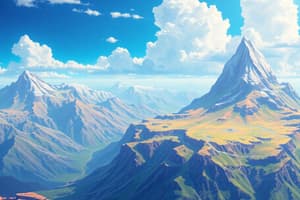Podcast
Questions and Answers
Which type of map represents concepts that are not directly visible?
Which type of map represents concepts that are not directly visible?
- Thematic map (correct)
- Line map
- Area map
- Point map
Which spatial feature has zero dimension and is specified using coordinates?
Which spatial feature has zero dimension and is specified using coordinates?
- Line
- Area
- Point (correct)
- Thematic map
What is the one-dimensional spatial feature that connects one place to another?
What is the one-dimensional spatial feature that connects one place to another?
- Line (correct)
- Thematic map
- Area
- Point
Which type of map represents two-dimensional phenomena as a two-dimensional symbology?
Which type of map represents two-dimensional phenomena as a two-dimensional symbology?
What is the main difference between discrete and continuous geographic phenomena?
What is the main difference between discrete and continuous geographic phenomena?
Which type of map involves more processing and interpretation of data and often represents concepts that are not directly visible?
Which type of map involves more processing and interpretation of data and often represents concepts that are not directly visible?
What is the spatial feature that exists in a singular location and has zero dimension?
What is the spatial feature that exists in a singular location and has zero dimension?
Which spatial feature defines boundaries, connects one place to another, and represents a linear component such as a road?
Which spatial feature defines boundaries, connects one place to another, and represents a linear component such as a road?
What represents two-dimensional phenomena as a two-dimensional symbology?
What represents two-dimensional phenomena as a two-dimensional symbology?
Which type of geographic phenomena has no defined boundaries or irrelevant boundaries?
Which type of geographic phenomena has no defined boundaries or irrelevant boundaries?
Flashcards are hidden until you start studying




